Nuclear Fusion Technology Research and Experimentation
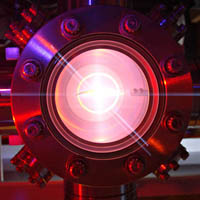
Xanatos Research into Nuclear Fusion Technologies and Related Fields
Fusion-AI Podcast: Leveraging Magnetic Compression on Electrostatically Generated Fusion Plasma
Notebook.lm Audio
A 20 minute deep dive into the approach to fusion we are researching as of December, 2024. The material here was generated from
a conversation with Claude.ai and David Xanatos regarding using intense magnetic fields to crush fusing plasma and cause significantly higher neutron
production rates. The transcript of this interchange was then fed into Google's Notebook.lm, which produced this discussion podcast. Note that
their system has some issues with reading exponential notation - so if they state something is "108 times larger", they are reading 10^8 as 108...
keeping that in mind - Enjoy!
(Note: If you cannot access the Google Notebook link, the direct wav audio file link is
https://www.xanatos.com/downloads/Claude and DX Discuss Fusion.wav)
We have broken new ground by standing on the shoulders of great researchers who have gone before us.
The image to the left is live fusion plasma in one of the first experiments conducted at Xanatos. This plasma was attained in a device
called an Inertial Electrostatic Confinement (IEC) Fusion Reactor, or "Fusor". Work started at Xanatos in October of 2014 to begin to create a laboratory
environment for conducting research into various forms and methods to create and sustain a fusion plasma. The decision was to use
Deuterium-Deuterium (DD) fusion initially as it had the lowest entry bar to success, especially in terms of safety, availability of
materials, and cost.
What is Nuclear Fusion?
Simply put, nuclear fusion occurs when conditions force two fusable atoms close enough together that they bond, forming a new, heavier atom.
The sun is powered by nuclear fusion - superheated Hydrogen under immense pressure creates the conditions by which the force that keeps atoms
from randomly merging on their own, called the Coulomb Barrier, can be overcome. Think of this Coulomb Barrier in the same way you would experience
the repulsive force of two magnets oriented towards each other with their same poles facing (north to north, or south to south.) As you bring these
magnets closer, the force required to do so increases exponentially.
When the atoms employed in fusion reactions, such as Hydrogen, or Deuterium, (which is referred to as "heavy Hydrogen" because of the
presence of a single extra neutron,) fuse, they release a very large quantity of energy by creating a new, stable atom. This energy is often in
the form of heat and some form of radiation - in the case of Deuterium - Deuterium fusion, this radiation takes the form of the liberation of
a single neutron, which makes it the signature detection method for fusion occuring in such systems. A highly charged Helium or Tritium atom is
also produced. The charges on these atoms may be harvested for energy, and the resultant &qouot;exhaust" of Helium or Tritium can be collected
and used in a variety of industrial applications for which there is significant demand.
The energies liberated from a fusion reaction - heat and radiation - are harvested to produce energy. There are a variety of methods both
proven and in use, as well as under development, to turn that energy into useful power. We will discuss these at length later in this document.
Fusion, it should be noted, is the opposite reaction from fission, which currently powers the working nuclear reactors around the globe. With
fission, heavy atoms, such as Uranium or Plutonium, are split in cascade or chain-reactions, releasing energy in the process. This energy is
then harvested as mentioned above, usually by turning the heat into steam to turn turbines, which produce electricity.
Why is it Important?
As our planet's population increases and our understanding and use of technology increases, we need greater and greater levels of power to
sustain our growth. Even the most die-hard proponents of fossil fuels will admit, at least in private, that there is a finite amount of
these fuels available for harvesting from planetary resources. Eventually, it will become more labor intensive - and more costly - to make these
fuels available, and at some point, there will simply not be enough left. If we have not developed reliable, clean power generation techniques
before that time, our species, as a whole, will fail.
In recognition of this reality, many technologies have sprung up to try to address this issue. Chief among these are our current nuclear
power generation stations. While they have gotten some very bad press because of large-scale accidents that have occurred at various times,
modern reactor design is much safer than ever before, and the dangers of radiation are blown way out of proportion because of the media's
propensity to sensationalize (this is not a swipe at the media - this is their job. They don't make money by telling us the news,
they make money by selling advertising time. Sensationalizing headlines and stories generates viewership, thereby increasing the value
of advertising time on their respective networks.) All this aside, however, modern nuclear power has some actual drawbacks, such as disposal
of waste products that are intensely radioactive, carcinogenic and difficult to contain, and have a half-life of thousands of years.
Hence, the interest in nuclear fusion. Nuclear fusion uses as its fuel readily available elements, such as Deuterium, that naturally occur
in seawater. According to Robert Steinhaus, who worked at Lawrence Livermore National Lab from 1974 to 2008, "It is estimated that the
complete conversion of deuterium releases 250 x 1015 joules of energy per metric ton. The
quantity of deuterium in seawater is estimated at 4.6 x 1013 metric tons. Therefore, the deuterium
present in seawater will yield around 5 x 1011 TeraWatt-Years of energy. At 2017 global energy
consumption values, that would supply us for 29.4 billion years worth of energy."
In addition, the resultant products of fusion reactions, primarily helium and tritium - have immediate commercial value and present no
environmental risk as a result. Furthermore, fusion reactors can't have a "meltdown" - if they lose containment, the plasma in the
chamber simply reverts to its normal gaseous state. While local damage to a reactor can occur, it is in the form of damage to the structure
of the reactor, or explosions of things like capacitor banks, which do not release radiation. The limited radiation that is produced
by fusion reactors can be contained with simple shielding.
All of this makes nuclear fusion the ideal power source for our planet going forward.
The full, global realization of nuclear fusion will be the most seismic shifting of human and national alignments the world has ever seen, and
will make it so that nations need no longer compete for limited energy resources. With this new, nearly unlimited energy supply online,
energy intensive projects, such as the desalination of sea water to create clean drinking water to regions that are dangerously lacking in this
precious resource, can move forward unhindered, sparking a new, dynamic economy and opening brand-new regions of food growth and production
in areas previously unable to sustain such efforts. A true re-greening of the planet, and a new lease on life for humanity.
What Research is Xanatos Conducting into Nuclear Fusion?
As a core research focus, Xanatos is investigating multiple configurations of fusion power possibilities, including alternate fuel
sources (such as proton-boron fusion and beam-on-target fusion), as well as researching the technically daunting aspects of fusion that have
delayed it for decades, such as loss-less plasma confinement strategies. Active construction of magnetic- and electrostatic-field generating
configurations within a fusion chamber and determining their effectiveness at "pinching off" plasma jets and leaks, is at the forefront
of our research efforts at this time.
Photos of the First Xanatos Inertial Electrostatic Confinement Fusion Reactor
Click any photo to view a larger image.
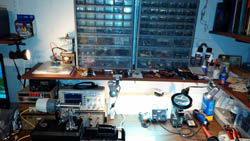
Starting off at the workbench
|
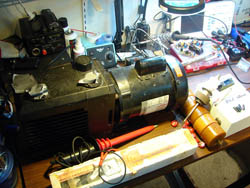
The Vacuum Pump before rebuild
|
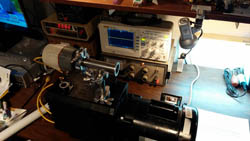
Vacuum gauge mounted on pump
|
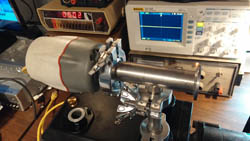
Closeup of vacuum gauge on pump
|
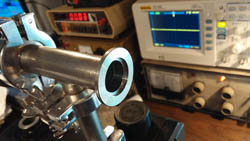
Vacuum piping connection
|

Read of Edwards vacuum gauge
|
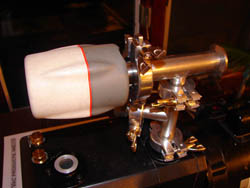
More vacuum gauge
|

More vacuum gauge back end
|
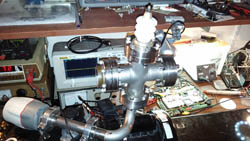
Bench testing setup
|
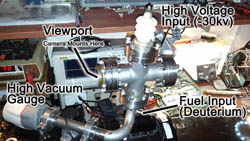
Bench testing setup, labeled
|
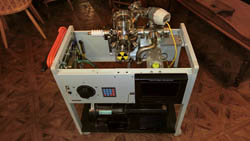
Start of initial build
|
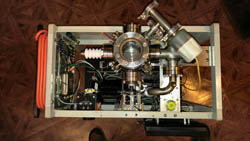
Start of initial build
|
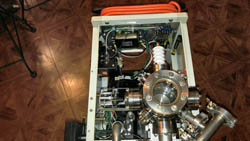
Start of initial build
|
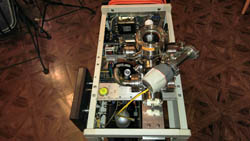
Start of initial build
|
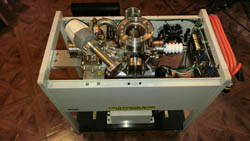
Start of initial build
|
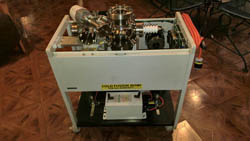
Start of initial build
|
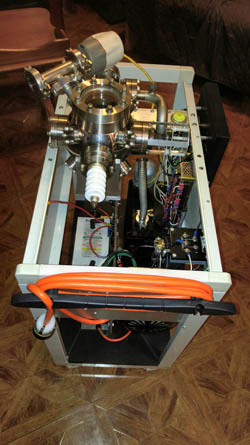
Start of initial build
|
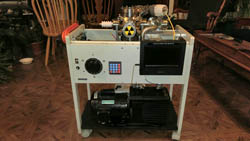
Start of initial build
|
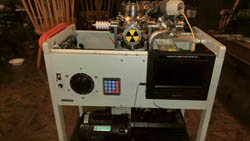
Start of initial build
|
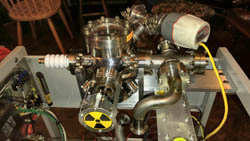
Start of initial build
|
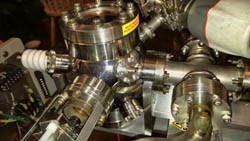
Start of initial build
|
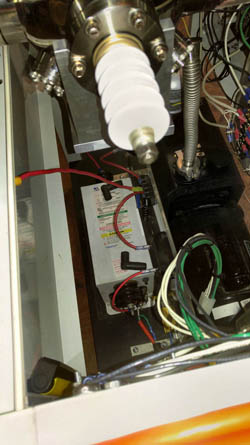
Start of initial build
|
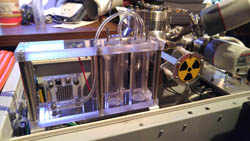
Later view of initial build
|
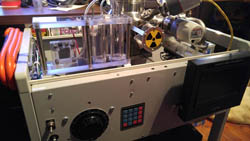
Later view of initial build
|
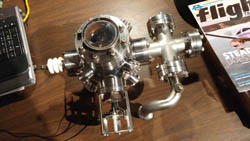
Fusion core removed for build upgrade
|
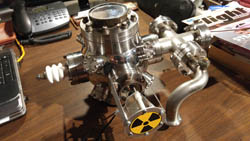
Fusion core removed for build upgrade
|
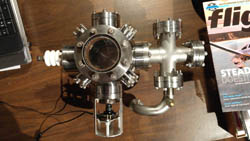
Fusion core removed for build upgrade
|
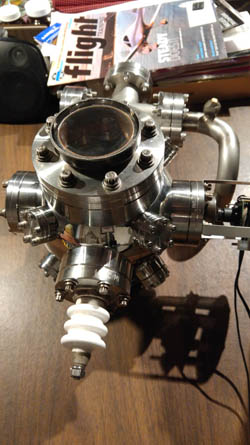
Fusion core removed for build upgrade
|
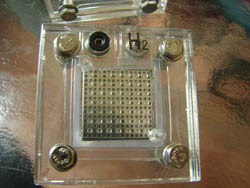
Deuterium gas generator, PEM Cell
|
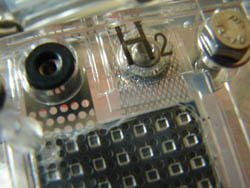
Deuterium gas generator, PEM Cell
|

Deuterium Gas Generator Construction
|
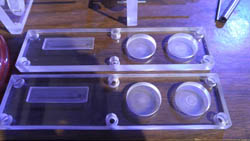
Deuterium Gas Generator Construction
|
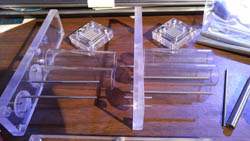
Deuterium Gas Generator Construction
|
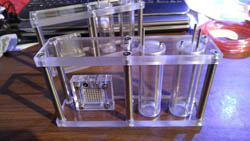
Deuterium Gas Generator Construction
|
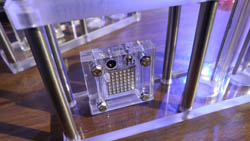
Deuterium Gas Generator Construction
|

Deuterium Gas Generator Construction
|
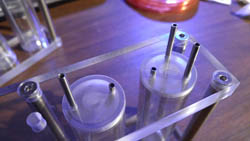
Deuterium Gas Generator Construction
|
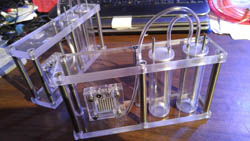
Deuterium Gas Generator Construction
|
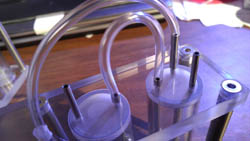
Deuterium Gas Generator Construction
|
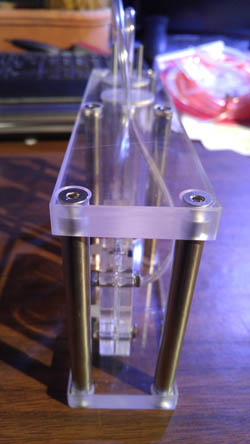
Deuterium Gas Generator Construction
|
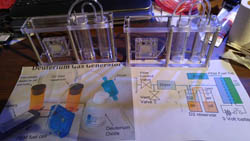
Deuterium Gas Generator Construction
|
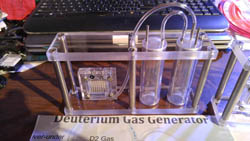
Deuterium Gas Generator Construction
|
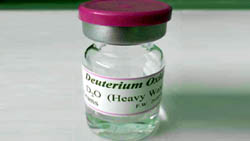
Deuterium Source (Heavy Water)
|

Later modification to DGG construction.
|
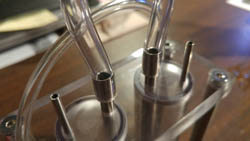
Note larger oil-transfer tube. Gas ports remain as-is.
|
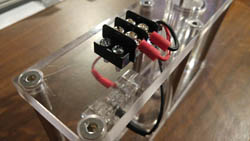
DGG Electrical connections
|
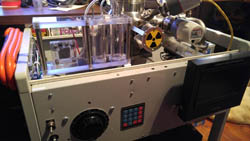
DGG installed in early build
|
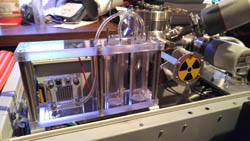
DGG installed in early build
|
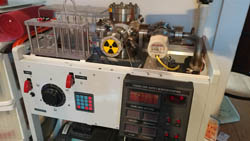
More recent build. Note change in front panel, vacuum piping
|
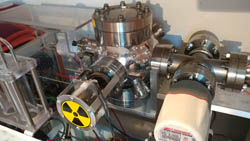
More recent build. Note change in front panel, vacuum piping
|
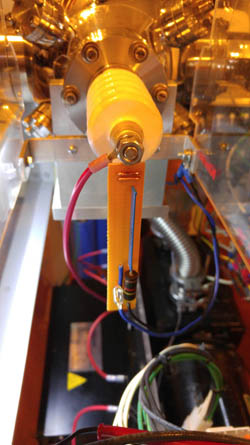
High-Voltage input post and Voltage divider network for metrology
|
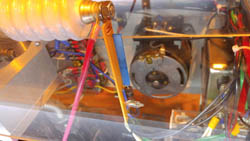
Side view of high Voltage input post setup
|

Front panel displaying arbitrary values for various voltages. Currently reading 8.8kV (decimal at the 10kV point)
|
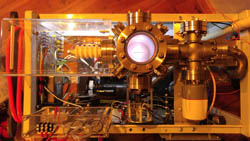
Top view, fusor in operation displaying first actual fusion plasma with deuterium
|
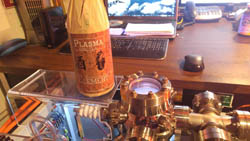
Celebrating plasma with... Plasma
|
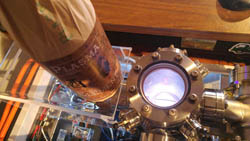
Celebrating plasma with... Plasma
|
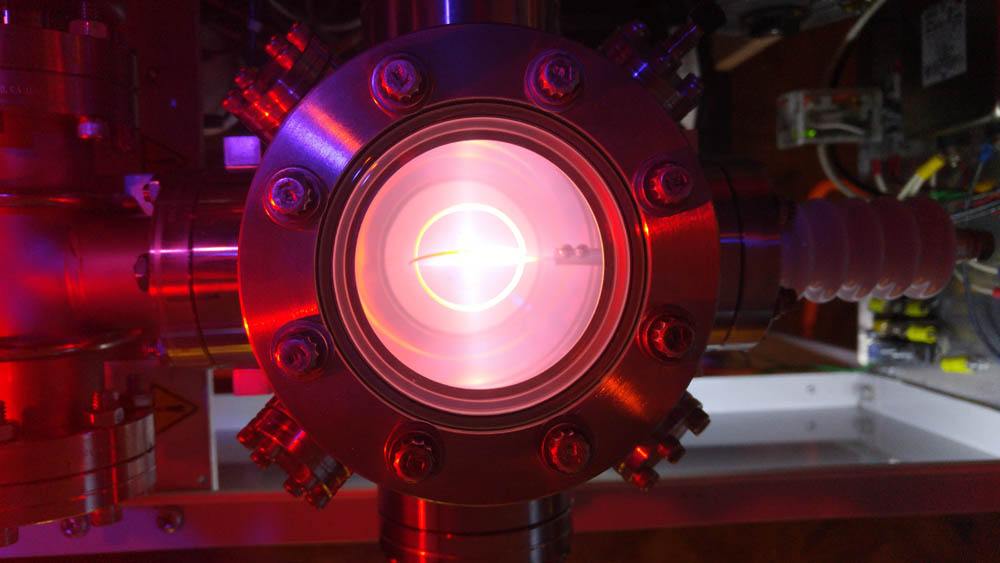
Cool factor of this shot demanded it get prominence. Red lighting was a lucky timing of the flashing "HV-On warning"
light post built into the system.
|
Technical Addenda and Reference Material
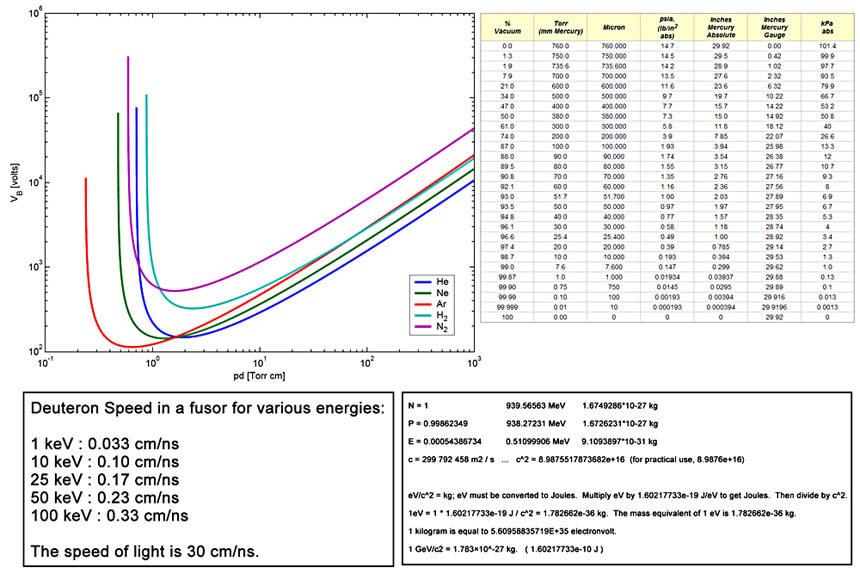
RETURN TO XANATOS